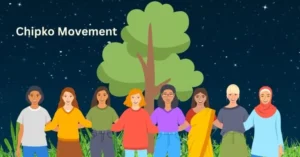
Why in news?
- The golden jubilee of the Chipko Movement, a landmark environmental movement that rose from the foothills of the Himalayas in Uttarakhand.
- This non-violent movement, known for its imagery of villagers embracing trees, left an indelible mark on India’s environmental consciousness.
Roots of the Chipko Movement (1970s)
- The lush forests of Uttarakhand faced a grave threat in the 1970s – rampant deforestation fueled by commercial logging.
- Large contractors, often from outside the region, were clearcutting trees to meet industrial demands.
- This posed a serious danger to the ecological balance of the Himalayas, threatening water sources, soil stability, and the livelihoods of local communities.
- The movement quickly gained momentum, spreading to other villages in the region. Men, women, and children alike participated in peaceful protests, using their bodies to form human chains around trees.
- This collective action garnered national attention, bringing the issue of deforestation to the forefront of public discourse.
The Power of Embracing (Chipko)
- The turning point came in 1973 in the village of Reni, where a group of women, led by Gaura Devi, confronted loggers who were about to fell trees.
- Drawing inspiration from Gandhian principles of non-violence, they resorted to a powerful act of protest – they wrapped their arms around the trees, essentially hugging them (chipko means “to embrace” in Hindi).
- This act of defiance not only physically stopped the loggers but also sent a powerful message – the villagers wouldn’t stand by and watch their forests disappear.
Leaders and Philosophies
- The Chipko Movement was not a singular effort. Several key figures played pivotal roles in its success. Chandi Prasad Bhatt, a Gandhian activist, spearheaded the movement’s early stages through his organization, the Dasholi Gram Swarajya Mandal (DGSM).
- He emphasized sustainable forest management and empowered local communities to have a say in decisions impacting their environment.
- Sundarlal Bahuguna, another prominent leader, drew inspiration from Gandhian ideals of non-violence and social justice.
- He played a crucial role in mobilizing local communities and spreading awareness about the importance of forests for ecological well-being.
Impact and Legacy
- The Chipko Movement’s impact went beyond stopping deforestation in a particular region. It became a symbol of resistance against environmental degradation across India.
- The movement’s success in pressuring the government led to a ban on commercial felling of trees in ecologically sensitive areas of Uttarakhand in 1981.
- More importantly, Chipko empowered local communities, particularly women like Gaura Devi, who became an icon of environmental resistance.
- The movement highlighted the importance of community participation in protecting natural resources and the critical role of forests in maintaining ecological balance.
Relevance in the 21st Century
- The Chipko Movement’s principles of sustainability, non-violent resistance, and community participation remain strikingly relevant today.
- As we grapple with climate change and environmental degradation, the movement serves as a potent reminder of the collective power of people to protect our planet.
- The Chipko legacy extends beyond India.
- It inspired similar movements worldwide, demonstrating the universality of the fight for environmental protection.
- The movement’s message of living in harmony with nature continues to resonate with environmental activists across the globe.
Looking Ahead: Continuing the Embrace
- The Chipko Movement serves as a wellspring of inspiration for future generations. Here are some key takeaways for moving forward:
- Empowering communities: Local communities must be active participants in decision-making processes concerning their environment. Their knowledge and traditional practices are invaluable for sustainable resource management.
- Sustainable practices: We need to adopt sustainable practices in forestry and other sectors to minimize environmental damage. This includes adopting alternative materials, promoting responsible consumption, and fostering a culture of respect for nature.
- Non-violent resistance: The Chipko Movement’s success demonstrates the effectiveness of non-violent resistance in achieving environmental goals. Peaceful protests, public awareness campaigns, and engaging with policymakers are crucial tools for creating positive change.
- The Chipko Movement’s story is one of courage, resilience, and the unwavering belief in the power of collective action. As we face ever-growing environmental challenges, let us embrace the spirit of Chipko and work together to protect our planet for generations to come.
People also ask
Q1: What was the Chipko Movement?
Ans: The Chipko Movement was a non-violent environmental movement in India that began in the 1970s. Villagers, particularly women, embraced trees (chipko means “to embrace” in Hindi) to prevent them from being cut down by loggers.
Q2 : When and where did the Chipko Movement take place?
Ans: The movement originated in the Himalayan region of Uttarakhand, India, in 1973.
Q3: Why was the Chipko Movement started?
Ans: The movement arose in response to rampant deforestation due to commercial logging, threatening the ecological balance and livelihoods of local communities.
Thank you for your sharing. I am worried that I lack creative ideas. It is your article that makes me full of hope. Thank you. But, I have a question, can you help me? https://www.binance.info/en-IN/register?ref=UM6SMJM3
Thank you for your sharing. I am worried that I lack creative ideas. It is your article that makes me full of hope. Thank you. But, I have a question, can you help me?